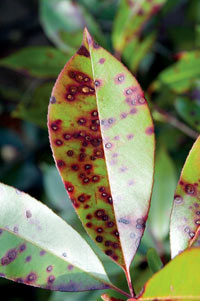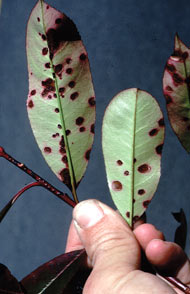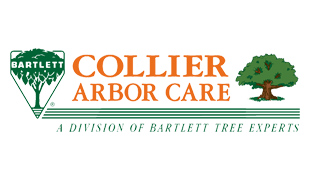|

Sunken gray centers are characteristic of the fungal leaf spot infection. Photinia Leaf SpotDownload a PDF of this articleDescriptionPhotinia is a widely grown shrub commonly used for hedges. Photinia is very susceptible to the fungus leaf spot called Entomosporium that can defoliate photinia plants. Plants AffectedSeveral species of photinia are susceptible including the commonly grown Photinia x fraseri or red tipped photinia. Other ornamentals that are affected by the blight include: Serviceberry, flowering quince, firethorn, Rhaphiolepsis and mountain ash. Symptoms/DamageNew infections appear as tiny circular leaf spots that are darker red than the surrounding tissue. Older necrotic (dead tissue) spots on photinia have ashen gray centers surrounded by a darker reddish halo. In heavy infections the spots coalesce to form large blighted areas. Infection will spread to twigs causing cankered areas on branches. Heavy infections will cause premature leaf drop resulting in large bare areas. The leaf spot can be easily confused with a physiological leaf spot. The difference is the physiological spot does not have the sunken gray centers characteristic of the fungal leaf spot infection. Life CycleThe fungus over winters on infected leaves and branches from the previous year. In the spring during wet weather, spores are released and are dispersed by splashing water and wind to infect new growth. Infection occurs continuously during periods of wet weather. Infection also occurs in the fall during autumn rains. ManagementA combination of cultural methods and treatments are needed to control this disease in our wet rainy northwest climate. CulturalPlant photinia in full sun and provide good air circulation. Photinia hedges have more disease problems than open grown single plants. Remove and destroy fallen leaves, prune off diseased twigs. Avoid overhead irrigation that keeps leaves wet for long periods of time. OrganicUse copper based products and treat according to the schedule below. ChemicalApply three to four treatments of an approved fungicide (some are systemic) starting at bud break in the early spring and continue at regular intervals during the spring until dry weather. Thoroughly treat all leaf and twig surfaces. The wetter and rainier the spring the worse the disease problem is. Also apply a dormant treatment before fall rains. |

Older necrotic (dead tissue) spots on Photinia have ashen gray centers surrounded by a darker reddish halo. |
|
Home |
Services |
The Arbor Advisor |
Garden Calendar |
About Us |
Fact Sheets |
Contact Us |
Site Map Collier Arbor Care Portland 503-722-7267 Vancouver (360) 693-6056 Site contents and design ©2013 Collier Arbor Care |





